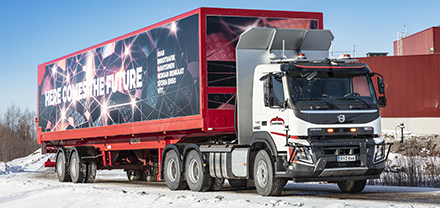Stora Enso began testing a self-driving truck for the transport of wood chips at its Uimaharju pulp and sawmill in Finland one year ago. With the help of this driverless vehicle, it can be established how much automated transport can reduce emissions and improve safety. The truck’s six senses enable its safe movement around the mill area. Source: Timberbiz
The test will continue during 2021.
By test-running the self-driving truck, Stora Enso has collected information on what kind of environmental and safety benefits and cost savings can be achieved with the state-of-the-art vehicle when driving around the mill grounds.
“The use of the automated truck has considerably increased safety in the mill area, particularly in the vicinity of wood chip piles and warehouses. The use of automation has also reduced emissions.
“Testing has gone well, and the truck does the right things in the right places. The test was planned to last for one year, but we have decided to continue it in order to gain a more. For example, the driver will in the future work in the remote-control room, and thus benefit from better ergonomics. The automated truck is expected to reduce emissions by optimising engine operation and route selection. Reduced fuel consumption will also bring financial savings.”
The truck’s six senses help it observe its environment
The maximum speed of the automated vehicle moving in the grounds of Stora Enso’s Uimaharju mill between the sawmill and the pulp mill is 20km per hour. The truck transports wood chips from the sawmill to the pulp mill, travelling the 1.4 km distance about 15 times a day. The woodchips, which are a by-product of sawmilling, are used as raw material for pulp production.
Safety is the number one issue in the testing of the vehicle. During the initial stage of the testing process, a driver has been in the truck’s cabin monitoring the progress of the test. Later this year, the operation of the truck will be controlled remotely from outside the vehicle.
A number of things are considered in the truck’s safety technology and that allow it to be called a truck with six senses. These senses are:
- Laser scanner or lidar: Measures the free space around the truck and forms three-dimensional information about obstacles for the truck’s system. Snow or thick fog canaffect the lidar’s perceptive abilities.
- Radar: Measures the free space around the vehicle two-dimensionally. Unlike the laser, the radar cannot perceive details, but weather conditions, on the other hand, do not affect its performance.
- Thermal-imaging camera: Detects heat sources in the vicinity, for example a person or vehicle.
- Sound detector: Recognises sounds taught to it such as a fire engine siren or a person’s cry for help. The truck can be set to stop or slow down when it hears a certain sound.
- Radio frequency transmitter: Persons moving around the mill grounds carry with them a small card that can be detected by an RFID reader in the vehicle. The truck can be set to stop when such an RFID tag is detected on or near the vehicle’s driving route.
- Camera: A moving image is the greatest benefit in the remote-control stage, allowing the driver working in the remote-control room to make decisions based on a live image that he/she sees and on other data received from the vehicle’s sensors. However, this is not an actual safety equipment. StoraEnso’s Enocell pulp mill produces dissolving pulp and softwood pulp for the needs of, for example, the textile and paper industries. A total of approximately 300 people work in the mill grounds.








